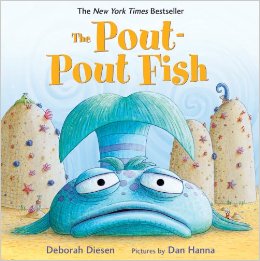Unlocking the Power of Children’s Literature in Middle and High School
This is part two of a series discussing ideas for incorporating classic children’s literature in ELA lessons for older students. To read part one, click here.
There’s definitely no shortage of timeless picture books to choose from, but in today’s post, I’m offering some options for using 3 of my kids’ personal children’s literature favorites in upper-level English and Reading classes.
The Pout-Pout Fish

Every time I read this book, I can’t stop thinking, The whole reason this book is so adorable (other than the cute little pout-pout fish that I want to kiss) is all of the poetic sound devices the author uses! This one is great for several different literary devices:
1.assonance: (a few examples)
- “so I spread the dreary-wearies all over the place” (ear)
- “with a wide winning grin” (short i)
- “crosstown frown” (ow)
2.alliteration: (a few examples)
- “lives a glum gloomy swimmer” (g)
- “tentacles all trailing” (t)
- “wish you wouldn’t greet us with a grimace and a growl” (g)
- “a slender squiggly sight” (s)
3.consonance: (a few examples)
- “daily scaly scowl”(l’s)
- “slender squiggly sight / she is squirmy, she is squelchy, she is slightly impolite” (l’s)
- “your hulky bulky sulking” (lk)
And seriously…the list goes on! This would be an excellent one for teaching the difference between couplets and quatrains as well. Plus, it will put everyone in a good mood. Who doesn’t like the Pout-Pout Fish?
A Tale of Two Beasts
Okay, so I don’t know if this one is technically a “classic” yet, but someday it should be. This book is perfect when it comes to helping students understand that a story can be told from different points of view.
In this tale, the girl thinks the little creature is a beast, and the little squirrel creature thinks the girl is the beast. The story is actually told twice…once from each point of view. It’s interesting to analyze the stories as a whole and also each page individually. This is literally the exact same plot line but told twice…once from each character’s perspective. Here is a list of questions you can use to begin a discussion about this book.
A Tale of Two Beasts is an ideal piece of children’s literature to discuss empathy. While each character begins by viewing the other as a monster, they spend time together, learn more about one another, and finally come to value each other’s differences.
How I Became a Pirate
I actually stumbled upon the fabulous wonder that is punctuation in this book while I was reading it to my four-year-old son. He loves this book, by the way. And now he’s obsessed with maps and searching for buried treasure.
Specifically, this picture book is ideal for teaching the difference between when and why writers would use dashes, parenthesis, and commas for pauses. It’s one thing to TELL students when to use each one, but when we show them how an author has used these punctuation marks to better his/her story, the concept really becomes powerful. Take these lines, for example:
By now it was past my bedtime. But nobody tells pirates to go to bed, to take a bath, or to brush their teeth. (Maybe that’s why their teeth are green.) Pirates sleep with one eye open — just in case. And they don’t change into pajamas — unless they want to. Pirates don’t do anything they don’t want to — except for maybe swabbing the decks.
I wanted to be a pirate forever.
After reading the entire book once, you can go back and focus on smaller sections like this one, asking questions such as these…
- Why does the author choose parentheses around the “Maybe that’s why their teeth are green” sentence instead of a dash?
- How do we read this sentence differently because of the parenthesis?
- Would the text make sense if the parentheses were dashes?
- As a writer, how might you decide whether to use dashes, commas, or parentheses?
We could go on for a long time discussing questions like that with different passages. In fact, this book has other author’s choice elements that teachers could model for students during a creative writing unit, like italicized text, larger and bolder text, figurative language, choppy sentences for effect, dialogue, and so on.
Children’s literature is a powerful tool for grade school and high school classrooms. Do you have ideas about how to incorporate them? Successful experiences teaching with picture books? Favorite classics you enjoy using? Please share in the comments below. We’d love to learn from you.




2 Comments
Comments are closed.